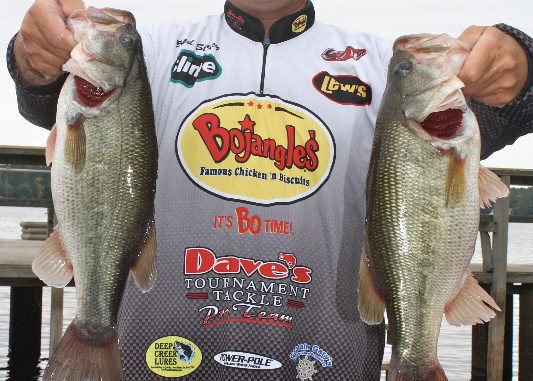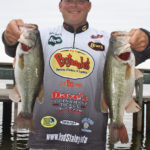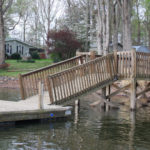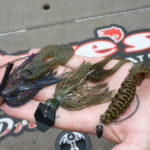
Learn how to flip soft-plastic baits and jigs around the thousands of docks that line High Rock Lake’s banks and you’re on your way to great summer bass fishing.
High Rock Lake, once known for its offshore structure and the 20-pound stringers that came from its deep-water haunts, has changed dramatically as a largemouth bass fishery. Crankbait specialists no longer dominate tournaments.
Why has the deep bite just about disappeared at High Rock? Numerous reasons have been cited, but most fishermen agree on the following ones.
First, summer drawdowns at High Rock have become scarce. Once known as “the yo-yo of the Yadkin” because of its fluctuating water level, High Rock has remained fairly high and constant in recent years. With the water up most of the time, there’s been little need for the fish to move out.
Another critical factor is the poor dissolved-oxygen levels at deeper depths. A 2013 report indicated that “the water coming into the project at High Rock has relatively low levels of dissolved oxygen” but there is substantially improved levels of dissolved oxygen thereafter.
Despite intense summer temperatures, most of the fish at the lake are being caught in less than 5 feet of water. With no oxygen in deeper waters and an abundant supply of forage in the shallows, bass are willing to tolerate the heat as long they can eat and breath.
As a result, shallow, shoreline cover has become the coveted hiding place for bass.
High Rock has limited shoreline cover unless it’s close to full pool, so its piers are the most-prevalent shallow-water cover. They offer the basic needs for survival: protection from the heat, abundant forage and sufficient oxygen levels.
Subsequently, High Rock has evolved into a premier pier-fishing lake throughout the summer, much to the delight of flipping fishermen and much to the chagrin of offshore structure fishermen.
Anglers having the most success probe the inner recesses of the lake’s docks and piers with plastic worms, creature baits, shaky head jigs, standard jigs and spinnerbaits. One of those flipping practitioners is Pleasant Garden’s Brad Staley, who fishes plenty of local and regional tournaments.
Staley is a dedicated flipping artist — to the extreme. He’s already had three surgical procedures, two on the right elbow and one of the left, to correct problems attributed to flipping.
While practicing for tournaments at High Rock, he follows a routine similar to other contestants. With temperatures in the 90s, he reasons that the fish should be out on offshore structure, though he’s heard of the shallow summer bite at the lake.
“Like other fishermen, I spend a lot of time fishing out during practice because conditions dictate that’s where the fish should be,” said Staley. “I figure if I can find that magic place where the fish are out, I’ll have it to myself because most other fishermen are fishing piers. But finding that deep offshore bite is like finding a needle in a haystack.”
Before long, Staley joins the multitude fishermen pounding the piers.
“I just can’t get bit fishing out at High Rock that amounts to anything, so I’m compelled to go to the piers like everyone else,” said Staley.
Since he has plenty of company around piers, Staley develops a strategy in selecting which piers to fish.
“Piers aren’t like hidden offshore structure; anyone can find a pier,” said Staley. “The piers at High Rock probably receive more fishing pressure than piers on any other body of water in the state.”
Staley’s strategy involves looking at the history of the lake in respect to piers.
“Historically, most of the tournaments at the lake are won from the piers in Abbotts Creek and Second Creek,” said Staley, who also notes the idiosyncrasies of the two creeks.
More than 10 miles long, Abbotts Creek is the biggest creek on the lake and one of the first to be highly developed with lakeside homes. As a result, it has a good number of old piers harboring brush piles planted by lakeside residents.
The winding creek has promising terrain for holding fish, featuring plenty of twists and turns from the Holloways Church Road Bridge on back with numerous piers dotting the shoreline along the way.
The creek’s main drawback, according to Staley, is that Abbotts is one of those creeks that can be on and off from year to year as far as the pier bite goes, and it experiences heavy boating traffic and fishing pressure.
“If you’re not scared off by the fishing pressure and the recreational traffic, you could be the one telling fishing stories at the weigh-in about how you won,” he said.
The pier bite is also inconsistent in the creek itself.
“Sometimes the fishing is best between the bridges (the NC 8 and Holloway Church Road bridges); at other times, the fish turn on in the backwaters behind the Holloway Church Road Bridge,” said Staley.
Second Creek has a more-consistent pier bite from year to year because its piers are constantly replenished by the bass released from the many tournaments held out of Tamarac Marina.
“Everybody knows Second Creek is a great area for pier fishing, but put 30 to 40 boats in there, and everybody is sharing the fish,” Staley said.
Crane and Swearing creeks at the upper end of the lake possess productive piers as well. Next to Abbots Creek, Swearing Creek has the most piers,while Crane is the second-biggest creek after Abbotts.
When the pier fish are biting in Crane Creek, they’re usually biting in Swearing Creek, too.
To find a productive stretch of piers in any of the creeks, fishermen must put in considerable time on the water.
“Spending time on the water, that’s the biggest thing,” said Staley. “Tournament anglers practice two to four days before a tournament to find the piers holding fish. You’ve got to match that if you’re going to compete. It’s hard to win by just showing up the day of the tournament.
“Certain areas with piers are a little hotter than others, and you need to stumble upon those areas. It’s hard to do, and it takes time and patience.”
Staley practices by running piers in an area where he’s caught fish before. He said if you’re not familiar with High Rock, you should begin in one of the major creeks and fish each pier slowly and thoroughly. You won’t get many bites making quick tosses and moving on to the next pier.
Just as some tree laps or points almost always hold fish and others rarely do, the same is true with piers. Since a fisherman can’t possibly fish every pier on the lake, Staley has a guideline for targeting certain piers and ignoring others, and his strategy sometimes runs counter to some of the basic rules for fishing piers.
“Pier fishing at High Rock is weird because it doesn’t follow the basics for fishing piers,” Staley said. “You’re supposed to fish piers near deep water or piers situated near points and bends. That doesn’t work much at High Rock because of its oxygen-poor waters.”
Instead, Staley targets flat piers and docks with long walkways in shallow water along flat banks. The ends of the piers should be in about 4 feet of water; any depth more than 4 feet is too deep. Most anglers report catching their fish in 3 feet of water or less.
On sunny days, piers provide shade, and the fish stay down; on cloudy days, the fish roam around them. The best bite takes place around 10 a.m. and later. Locals call it “the dinner bell bite” because during the heat of the day the fish are tightly locked to the piers.
Because Staley flips, his approach involves stealth. He keeps his boat a fair distance from the piers to avoid spooking the fish by making noise or by “blowing up silt” with his trolling motor.
“That’s why I have two Power Poles mounted on my boat,” said Staley. “I can sit still a distance away without making any disturbance. The bass at High Rock are exposed to so many trolling motors, they know them by name.”
Staley’s strategy includes fishing two piers at once by positioning his boat between two piers so he can flip or pitch both by turning his body or by moving across to the opposite side.
“I don’t weave in and out and around each pier to fish,” he said. “I get to cover more ground that way, too.”
Despite the number of piers he covers, Staley said it takes a long time to fish piers effectively at High Rock.
“You can’t make a cast or two at a pier and move on; you must fish each pier thoroughly,” he said. “The water’s so dirty, the fish are so pressured, and the fish are so lazy, they won’t swim far to hit a bait. You’ve got to fish every piece of brush, every pole, every dock edge, and every wood cross beam. It’s amazing how many times you have to toss at a pole and even hit the pole to provoke a strike.”
Staley favors floating docks and fishes those methodically. He looks for breaks on his depth finder a short distance from the ends of the docks. If he spies any, he fishes those first. Then he skips his bait into each entry hole at the front of the floating dock, then does likewise down each side of the dock.
He said the place where the walkway meets the floating section is the dock’s sweet spot. The juncture creates a shade line that holds bass.
If the depth at the dock is less than 5 feet, he lets the bait go to the bottom; if it’s a little deeper, he swims the bait or yo-yos the bait back to the boat.
Staley usually skips a 1/2-ounce Dave’s Tournament Tackle banana-style jig in green pumpkin or black/blue with a color-coordinated Deep Creek Katie Bug trailer, a swimming-style plastic with lots of action. The jig makes a commotion moving through the water, and Staley believes that attracts bass. He works the jig back rapidly to trigger reaction strikes.
Staley skips baits under docks by using firm flip casts and by selecting jigheads with skipping potential if they land correctly. The skipping baits are reminiscent of youngsters sidearming thin rocks to skip along the water.
“The banana-style jig is flat on one side and skips better for me,” said Staley. “I’ve tried many different styles, but most tend to dig into the water as soon as they hit instead of skipping like a rock. Many fishermen prefer a 1/4-ounce jig for a slower fall, but I use the heavier jig because it moves more water.”
Staley occasionally flips plastic creature baits like the Deep Creek Junior Super Razor Beetle, a beaver-style bait, and even a Zoom Ol’ Monster worm.
Staley’s equipment is geared for pier fishing. He uses a 7-foot, extra heavy Wild Black Carrot Stik rod for hook penetration and for maneuvering fish through and around cross beams and pilings. His Lew’s reel has a 7.3-to-1 retrieve ratio so he can catch up with a fish in a hurry. The reel is spooled with 20-pound test Sunline fluorocarbon that’s tough enough to ward off the effects of brads, nails, pole splinters and other hazards associated with pier fishing.
Staley said once you’re able to distinguish the potentially productive piers from the also-rans, your efforts will be reflected by the increased number of summer bass in your livewell.
DESTINATION INFORMATION
HOW TO GET THERE — High Rock Lake is south of Lexington between US 29 and NC 8. The main gateway is the Southmont Landing at Abbotts Creek off NC 8. Other launch sites are the Flat Swamp Access off NC 8 and the Second Creek Access and Tamarac Marina, both off Bringle Ferry Road near Salisbury.
WHEN TO GO — Summer and early fall are the most-productive times for shallow-water pier fishing, assuming the lake level remains high. Abbotts Creek and Swearing Creek have the most piers.
BEST TECHNIQUES — Flipping piers with creature baits, jigs, plastic worms and shaky head jigs accounts for most of the catches. Occasionally, swimbaits and small crankbaits see some action. Medium-heavy to heavy spinning and baitcasting gear is needed along with 10- to 17-pound test line that’s abrasion resistant.
FISHING INFO/GUIDES — Maynard Edwards, Yadkin Lakes Guide Service, 336-249-6782. See also Guides and Charters in Classifieds.
ACCOMMODATIONS — Days Inn, Lexington, 336-357-2333; Highway 8 Motel, Lexington, 336-357-6444; Quality Inn, Lexington, 336-243-2929.
MAPS — Fishing Hot Spots, 800-ALL-MAPS, www.fishinghotspots.com.







Be the first to comment